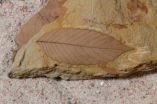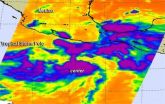(Press-News.org) 66 million years ago, a 10-km diameter chunk of rock hit the Yukatan peninsula near the site of the small town of Chicxulub with the force of 100 teratons of TNT. It left a crater more than 150 km across, and the resulting megatsunami, wildfires, global earthquakes and volcanism are widely accepted to have wiped out the dinosaurs and made way for the rise of the mammals. But what happened to the plants on which the dinosaurs fed?
A new study led by researchers from the University of Arizona reveals that the meteorite impact that spelled doom for the dinosaurs also decimated the evergreen flowering plants to a much greater extent than their deciduous peers. They hypothesize that the properties of deciduous plants made them better able to respond rapidly to chaotically varying post-apocalyptic climate conditions. The results are publishing on September 16 in the open access journal PLOS Biology.
Applying biomechanical formulae to a treasure trove of thousands of fossilized leaves of angiosperms — flowering plants excluding conifers — the team was able to reconstruct the ecology of a diverse plant community thriving during a 2.2 million-year period spanning the cataclysmic impact event, believed to have wiped out more than half of plant species living at the time. The fossilized leaf samples span the last 1,400,000 years of the Cretaceous and the first 800,000 of the Paleogene.
The researchers found evidence that after the impact, fast-growing, deciduous angiosperms had replaced their slow-growing, evergreen peers to a large extent. Living examples of evergreen angiosperms, such as holly and ivy, tend to prefer shade, don't grow very fast and sport dark-colored leaves.
"When you look at forests around the world today, you don't see many forests dominated by evergreen flowering plants," said the study's lead author, Benjamin Blonder. "Instead, they are dominated by deciduous species, plants that lose their leaves at some point during the year."
Blonder and his colleagues studied a total of about 1,000 fossilized plant leaves collected from a location in southern North Dakota, embedded in rock layers known as the Hell Creek Formation, which at the end of the Cretaceous was a lowland floodplain crisscrossed by river channels. The collection consists of more than 10,000 identified plant fossils and is housed primarily at the Denver Museum of Nature and Science. "When you hold one of those leaves that is so exquisitely preserved in your hand knowing it's 66 million years old, it's a humbling feeling," said Blonder.
"If you think about a mass extinction caused by catastrophic event such as a meteorite impacting Earth, you might imagine all species are equally likely to die," Blonder said. "Survival of the fittest doesn't apply — the impact is like a reset button. The alternative hypothesis, however, is that some species had properties that enabled them to survive.
"Our study provides evidence of a dramatic shift from slow-growing plants to fast-growing species," he said. "This tells us that the extinction was not random, and the way in which a plant acquires resources predicts how it can respond to a major disturbance. And potentially this also tells us why we find that modern forests are generally deciduous and not evergreen."
Previously, other scientists found evidence of a dramatic drop in temperature caused by dust from the impact. "The hypothesis is that the impact winter introduced a very variable climate," Blonder said. "That would have favored plants that grew quickly and could take advantage of changing conditions, such as deciduous plants."
"We measured the mass of a given leaf in relation to its area, which tells us whether the leaf was a chunky, expensive one to make for the plant, or whether it was a more flimsy, cheap one," Blonder explained. "In other words, how much carbon the plant had invested in the leaf." In addition the researchers measured the density of the leaves' vein networks, a measure of the amount of water a plant can transpire and the rate at which it can acquire carbon.
"There is a spectrum between fast- and slow-growing species," said Blonder. "There is the 'live fast, die young' strategy and there is the 'slow but steady' strategy. You could compare it to financial strategies investing in stocks versus bonds." The analyses revealed that while slow-growing evergreens dominated the plant assemblages before the extinction event, fast-growing flowering species had taken their places afterward.
INFORMATION:
Please mention PLOS Biology as the source for this article and include the links below in your coverage to take readers to the online, open access articles
All works published in PLOS Biology are open access, which means that everything is immediately and freely available. Use this URL in your coverage to provide readers access to the paper upon publication:
http://www.plosbiology.org/article/info:doi/10.1371/journal.pbio.1001949
Contact: Benjamin Blonder,
Department of Ecology and Evolutionary Biology,
University of Arizona,
bblonder@gmail.com
Citation: Blonder B, Royer DL, Johnson KR, Miller I, Enquist BJ (2014) Plant Ecological Strategies Shift Across the Cretaceous–Paleogene Boundary. PLoS Biol 12(9): e1001949. doi:10.1371/journal.pbio.1001949
Funding: BB was supported by a Rocky Mountain Biological Laboratory graduate research fellowship, a Geological Society of America student research grant, and a NSF pre-doctoral fellowship. BE was supported by an NSF ATB and Macrosystems award (Grant numbers: Macrosystems - NSF DEB 1065861; ATB - NSF EF 0742800). The funders had no role in study design, data collection and analysis, decision to publish, or preparation of the manuscript.
Meteorite that doomed the dinosaurs helped the forests bloom
2014-09-16
ELSE PRESS RELEASES FROM THIS DATE:
The genetics of coping with HIV
2014-09-16
We respond to infections in two fundamental ways. One, which has been the subject of intensive research over the years, is "resistance," where the body attacks the invading pathogen and reduces its numbers. Another, which is much less well understood, is "tolerance," where the body tries to minimise the damage done by the pathogen. Now an elegant study using data from a large Swiss cohort of HIV-infected individuals gives us a tantalising glimpse into why some people cope with HIV better than others.
The authors find that tolerance varies substantially between individuals, ...
Point-of-care CD4 testing is economically feasible for HIV care in resource-limited areas
2014-09-16
A new point-of-care test to measure CD4 T-cells, the prime indicator of HIV disease progression, can expedite the process leading from HIV diagnosis to antiretroviral therapy (ART) and improve clinical outcomes. Now a study by Massachusetts General Hospital (MGH) investigators, working in collaboration with colleagues in Mozambique and South Africa, indicates that routine use of point-of-care CD4 testing at the time of HIV diagnosis could be cost effective in countries where health care and other resources are severely limited. Their analysis is being published in the ...
Nanoribbon film keeps glass ice-free
2014-09-16
Rice University scientists who created a deicing film for radar domes have now refined the technology to work as a transparent coating for glass.
The new work by Rice chemist James Tour and his colleagues could keep glass surfaces from windshields to skyscrapers free of ice and fog while retaining their transparency to radio frequencies (RF).
The technology was introduced this month in the American Chemical Society journal Applied Materials and Interfaces.
The material is made of graphene nanoribbons, atom-thick strips of carbon created by splitting nanotubes, ...
Journal of Clinical Psychiatry: Long-term benefit of NeuroStar TMS Therapy in depression
2014-09-16
Malvern, Pennsylvania, September 16, 2014 – Neuronetics, Inc., today announced that results of a study designed to assess the long-term effectiveness of NeuroStar TMS Therapy in adult patients with Major Depressive Disorder (MDD) who have failed to benefit from prior treatment with antidepressant medications, were published online in The Journal of Clinical Psychiatry. The study found that TMS treatment with the NeuroStar TMS Therapy System induced statistically and clinically meaningful response and remission in patients with treatment resistant MDD during the acute phase ...
NASA spots center of Typhoon Kalmaegi over Hainan Island, headed for Vietnam
2014-09-16
NASA's Aqua satellite saw Typhoon Kalmaegi's center near northern Hainan Island, China when it passed overhead on September 16 at 06:00 UTC (2 a.m. EDT). Hours later, the storm crossed the Gulf of Tonkin, the body of water that separates Hainan Island from Vietnam, and was making landfall there at 11:30 a.m. EDT.
The Moderate Resolution Imaging Spectroradiometer or MODIS instrument aboard Aqua captured a picture of the typhoon that shows the center near the northern end of Hainan Island, China, while the storm stretches over the mainland of southeastern China, east into ...
Computerized emotion detector
2014-09-16
Face recognition software measures various parameters in a mug shot, such as the distance between the person's eyes, the height from lip to top of their nose and various other metrics and then compares it with photos of people in the database that have been tagged with a given name. Now, research published in the International Journal of Computational Vision and Robotics looks to take that one step further in recognizing the emotion portrayed by a face.
Dev Drume Agrawal, Shiv Ram Dubey and Anand Singh Jalal of the GLA University, in Mathura, Uttar Pradesh, India, suggest ...
Newborn Tropical Storm Polo gives a NASA satellite a 'cold reception'
2014-09-16
The AIRS instrument aboard NASA's Aqua satellite uses infrared light to read cloud top temperatures in tropical cyclones. When Aqua passed over newborn Tropical Storm Polo off of Mexico's southwestern coast it got a "cold reception" when infrared data saw some very cold cloud top temperatures and strong storms within that hint at intensification.
Polo formed close enough to land to trigger a Tropical Storm Watch for the southwestern coast of Mexico. The watch was issued by the government of Mexico on September 16 and extends from Zihuatanejo to Cabo Corrientes, Mexico. ...
EARTH Magazine: The Bay Area's next 'big one could strike as a series of quakes
2014-09-16
Alexandria, Va. — Most people are familiar with the Great 1906 San Francisco Earthquake and are aware of the earthquake risk posed to the Bay Area — and much of California — by the San Andreas Fault. Most people are not aware, however, that a cluster of large earthquakes struck the San Andreas and quite a few nearby faults in the 17th and 18th centuries. That cluster, according to new research, released about the same amount of energy throughout the Bay Area as the 1906 quake. Thus, it appears that the accumulated stress on the region's faults could be released in a series ...
New research decodes virus-host interactions in ocean dead zones
2014-09-16
A complex web of interaction between viruses, bacteria, and their environment is becoming ever more untangled by a growing international collaboration between Matthew Sullivan, associate professor in the University of Arizona's Department of Ecology and Evolutionary Biology and Steven Hallam from the University of British Columbia in Vancouver, Canada.
"Bacteria are drivers of nutrient and energy cycles that power the earth," Sullivan said. "As the climate is changing, so are the environments these bacteria live in, and they in turn loop back to impact their environments. ...
New research shows tornadoes occurring earlier in 'Tornado Alley'
2014-09-16
BOZEMAN, Mont. -- Peak tornado activity in the central and southern Great Plains of the United States is occurring up to two weeks earlier than it did half a century ago, according to a new Montana State University study whose findings could help states in "Tornado Alley" better prepare for these violent storms.
Tornado records from Nebraska, Kansas, Oklahoma, and northern Texas – an area of high tornado activity dubbed "Tornado Alley" -- show that peak tornado activity is starting and ending earlier than it did 60 years ago.
Peak tornado activity, which occurs ...



